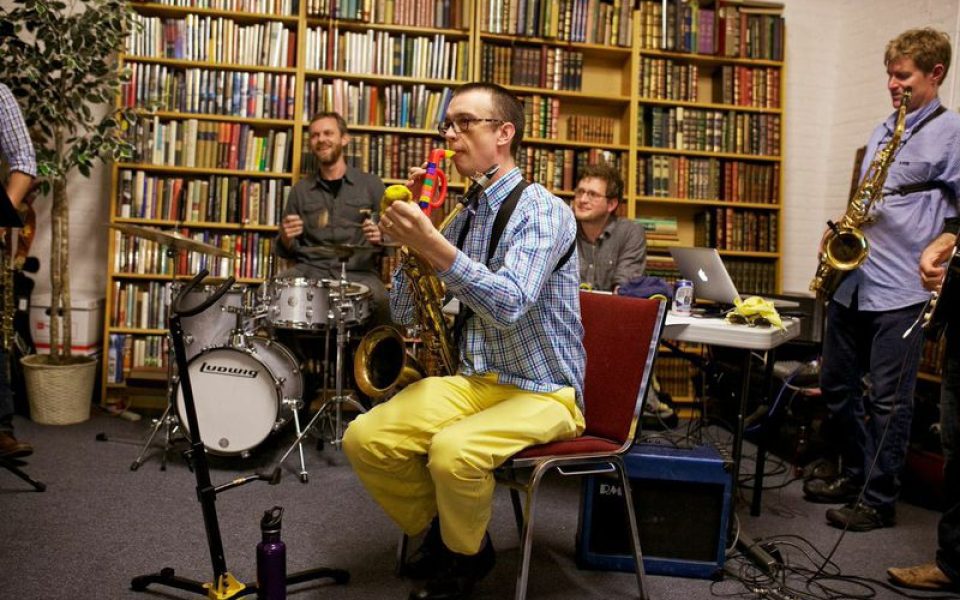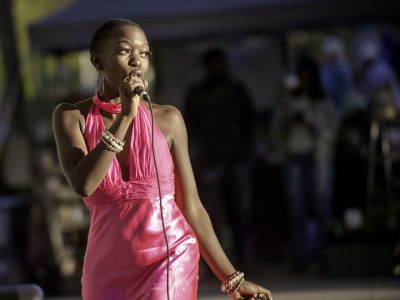Chris Robinson (photo by Caleb Smallwood)
by Jordan Green
“At their last performance, Brianna made tunnels through the aisles with gauze, and the dancers moved through,” says Robert Beasley, the new owner of Empire Books. “I think this performance is going to be tame in comparison.”
Brianna Taylor, an adjunct professor at different area colleges who leads the dance section of Collapss, takes a wide stance like a ballhandler or wrestler, ready to respond to the most subtle signal.
There’s a second dancer, a triad of trumpeters, saxophonists, a drummer, a standup-bass player, a violinist, an electronic artist making music on a laptop, some oboists and a guitar player — more than a dozen players in all. The audience, buzzing with anticipation on this First Friday evening, is roughly twice the size of the ensemble, itself a conglomeration of Greensboro-based Collapss and Triangle-based Polyorchard, two improvisational music groups made up of classically trained players.
And holding center court is Laurent Estoppey, a Swiss saxophonist and composer who has lived in Greensboro since 2010. He’s playing the role of “commander.”
“I have almost no influence on what they do, I mean the sounds they make, but I only control the structure of the music,” he says of the musicians. “They will come to hate me. You will see them put on a headband or hat and become a guerilla. They are going to revolt against me and try to take over.”
This will be the second performance of “Cobra,” a 1984 piece by avant-garde composer John Zorn, by the conjoined groups, the first having taken place in Durham about a week earlier. “Cobra” has been performed many times by different groups over the years, but Estoppey said he believes Collapss is the only group that includes a dance component.
The piece begins with Brianna performing a kind of loose-limbed ballet. A saxophone player and a drummer come in together, building a tentative jam that sounds like an orchestra tuning up. Estoppey grabs an oversized cue card inscribed with the letter “R” from a folding table and flashes it at Carole Ott, a vocalist who teaches at UNCG, and Tadeu Coelho, a flutist who is a member of the faculty at UNC School of the Arts. Ott and Coelho respond to the prompt with short, nearly identical bursts of sound, smiling as they trade articulations.
Then Estoppey picks up another cue card bearing the letters “SX” and flashes it toward the trombone players. They respond with a cacophonous hum best described as a flock of seagulls with theremins caught in their throats. Estoppey lowers his arms with palms open, bringing the volume down, and then throws his hands up. The instruments shriek like animals experiencing primal pain, and the dancers cry, “Wow!” and “Yes!”
“Cobra” is one of a series of compositions that Zorn has described as “game pieces.” The conductor, or “commander,” prompts the musicians and dancers to play or rest, or suggests collaborations between particular players, but only the individual participants know how they will respond to each cue. And sometimes even the tenuous order imposed by the commander breaks down as the participants pursue their own agendas.
About midway through Collapss and Polyorchard’s joint performance at Empire Books, the violinist pulls a book off a shelf and starts barking phrases from it, while one of the dancers gyrates wildly. One of the trumpeters, who is wearing a shirt that says “Durham: It’s not for everyone” exclaims, “Laurent looks like Stephen Colbert, and it’s freaking me out!”
Just when it seems the scene can’t get any more strange and wonderful, Ott vocalizes a sound that’s like an angry trombone. Internalizing the dialectic between wonder and fright, a young girl from the audience starts to dance while pointing her index fingers in the air. She crouches on the floor and then leaps into her mother’s lap, burying her head in her side.
By now the trumpeter with the “Durham” shirt has donned a plastic rain bonnet and is roaming the floor with a question-mark cue card, while the violinist stalks him and tries to wrest the cue card from his hands.
Some participants perform in tandem with each other while others respond to particular cues in counterpoint with one another. Ott and Coelho, the vocalist and flautist, mimic each other, while Taylor and the other dancer respond to the same cue by respectively giving a banshee yell and making a series of high kicks.
At any given time, the guitar might squeal, an alto saxophone might trill, a dancer might growl and a musician might pick up an empty Yuengling and start tapping it with a chopstick. There’s a sense that, while every player is a virtuoso in her respective discipline, there are no right or wrong notes or gestures, and no hierarchy of instruments or performers.
Over the course of the concert, which lasts about an hour, Estoppey becomes increasingly dictatorial, waving the question-mark cue card at individual players, and drawing his index and middle fingers across his throat in the sign for “cut.”
The music seems to vacillate from explosions of chaos and coalescing back into coherent forms like a giant sonic undulation.
“You just need people to play; it doesn’t matter if they’ve played together before or not,” says David Menestres of Polyorchard after the performance. “The whole point of this is to break those bonds apart.”
Much of the dynamic of each performance of “Cobra” depends on the energy that each performer brings to it, and the energy the audience brings to the show. Coelho and Ott in particular share a certain chemistry with one another.
“We work together instead of fight,” Coelho says after the show.
Their lips meet in a full-bodied smooch.
“And there’s this,” Ott says.
Join the First Amendment Society, a membership that goes directly to funding TCB‘s newsroom.
We believe that reporting can save the world.
The TCB First Amendment Society recognizes the vital role of a free, unfettered press with a bundling of local experiences designed to build community, and unique engagements with our newsroom that will help you understand, and shape, local journalism’s critical role in uplifting the people in our cities.
All revenue goes directly into the newsroom as reporters’ salaries and freelance commissions.





Leave a Reply